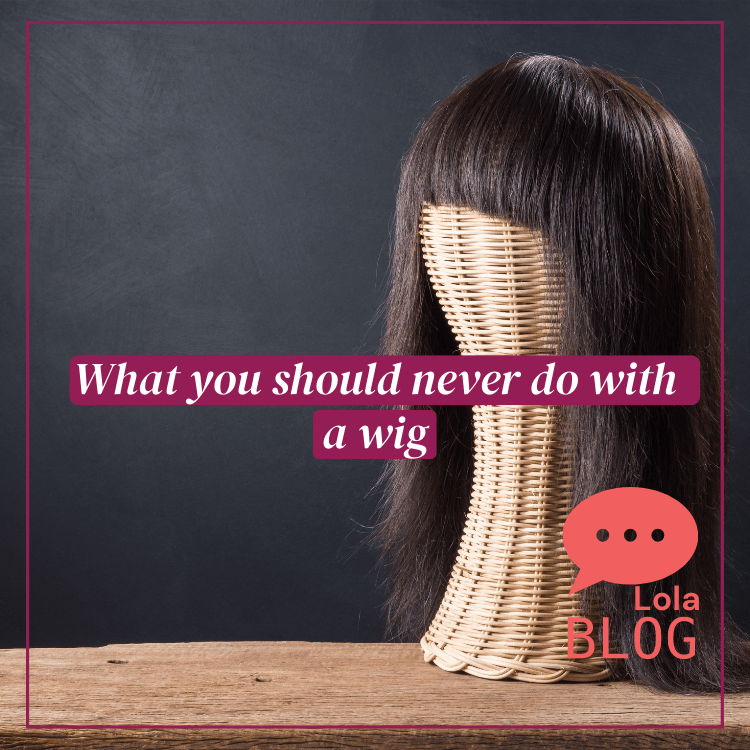
What you should never do with a wig
Share
Wigs are a great way to experiment with a new hairstyle, but they can cause serious harm to your hair and scalp if you aren't careful. Maintaining a healthy hair routine is essential while sporting a protective style, such as a wig. Here are some things to keep in mind when donning a wig.
These are the things not to do with a wig:
Do not wear the wrong size
In addition to making you look and feel awful, a wig that doesn't fit properly can create all kinds of problems. LolaSilk wigs have straps to adjust the wig to fit comfortably on just about any head shape or size.
Attach the wig correctly

Many people avoid wearing wigs because they are embarrassed by the possibility of the wig coming off in public or because they are unsure of how to properly attach the wig. Combs, clips, and glue are common methods for securing wigs, but they aren't always the most current method to use. It is recommended that if adhesive is required for a particular style, it be used sparingly and in small amounts to avoid hair loss and breakage around the hairline. It's best to steer clear of wigs made from irritating materials if your scalp is particularly delicate. Wig bands are a great alternative as they are worn beneath the wigs to keep them in place without causing any harm to the wearer's natural hair or the wig's fine lace.
Avoid curling irons and blow driers
Wigs are easily damaged by any kind of heat source. If you aren't using a synthetic wig that can withstand heat, your styling tools will melt the fibres and harm your wig. Human hair wigs are also damaged by the use of heat styling products. Wig caps do not produce the same moisture as hair that grows from the scalp since the scalp produces its own natural moisturising oils. Heat tools are extremely abrasive to the delicate strands of real hair wigs and can cause lasting damage.
Take care of your hairline
Although stocking caps shield your hair from damage and keep it smooth under wigs, making them less noticeable, they can be drying and damaging to the hairline. The stocking cap should be slid behind the ear to protect the skin around the ears. A wig band can be used to protect the region around your hairline. Wig bands are designed to shield the hairline and keep wigs in place. As a result, you'll need less of the pins and clips that are usually used to secure the wig to your head.
Brushing with a regular brush is not recommended
Typical hair care tools, such as brushes and combs, can be quite aggressive. Brushes and combs that are used on natural hair can damage a wig irreparably because they stretch the fibres. In addition to messing up the look, that can also make the wig's hair come loose. Instead of using a regular brush, switch to a wig brush or wide-tooth comb. If you want volume, try a comb with wide teeth and a non-slip grip, or a metal comb that defrizzes as it detangles. The initial cost of purchasing a wig comb will be more than offset by the extended life of your full and lush wig.
Do not sleep with your wig on
Experts on hair care advise against sleeping in a wig because doing so drastically shortens the weave's life span. While we sleep, our hair rubs against the pillow, causing static, tangles, and dryness that can be detrimental to our wigs. If you sleep in your wig, it will not last as long as if you took it off at night. You can aggravate your scalp by sleeping in your wig. When worn overnight, oils and sweat can accumulate. Hair may become unattached from the cap or the frequency with which the wig must be washed may rise as a result of the buildup of oils and other substances in the wig cap.
Do not neglect your own hair
Keep your own hair clean and conditioned at all times. There is no excuse for dirty, unruly, or dry hair if you wear a wig. Even though it's tempting to put off washing your hair, you should still do so on a regular basis to get rid of buildup of dirt and bacteria on the scalp and strands.
Avoid swimming
Both chlorinated water and saltwater can cause dry, brittle hair. Unlike chlorine, which contains disinfectants that leave hair dry and dull, saltwater actually draws moisture out of hair, leaving it brittle and lifeless. Swap out your wig for a flowery or turbaned swim cap for a more vintage look. A regular swim cap is better for swimmers who don't want to stand out.
Browse our range of Brazilian wigs for sale.